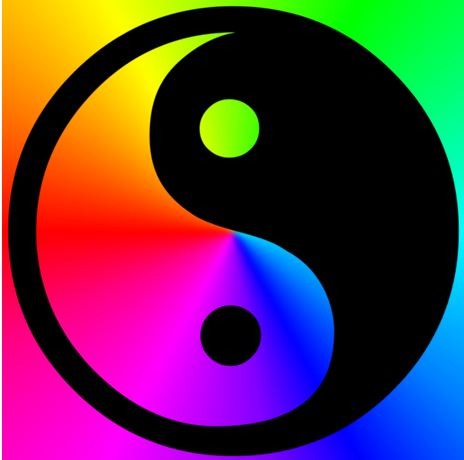In my endeavor to contribute to the balance between masculine and feminine I increasingly realize that a balanced mode of expression is actually also required. That is fairly easy when talking about male and female as energetic qualities, as I´ve already done.
However as soon as it applies to gender – as in my previous article where I encourage men to wear skirts and specifically don´t mean men who enjoy dressing up as women or are playing with it, like dragqueens… But “real guys” …it becomes complicated. For one or the other dragqueen might be more of a “real guy” in his daily male life as one or the other man, to whom it would never occur to equip himself with female attributes and yet appears to be more feminine, or to use a more old fashioned term – effeminate than he is aware of or likes.
Male and female is not always masculine and feminine
Under certain circumstances some men appear to be more feminine than some women and some women can appear more masculine than some men – sometimes intentionally, sometimes not… and very quickly stereotypes and prejudice creep into the discussion. For so far our use of language is often vague or, to be more polemic: it´s really easy in talking about this subject to get caught in the electrical fences of various states of minds – perhaps comparable to discussions about racism or antisemitism.
And so I realized that I have to pay attention not to evoke the opposite of what I am aiming for: naturally more acceptance, tolerance and courage in expressing one´s individuality – particularly where it concerns our dealing with the masculine-feminine within us and others…
Possible metaphors
Obviously the polarity of the biological genders is much less black and white than the conventions of our culture and the media tend to convey. There is not only “the male” and “the female”! But a broad spectrum inbetween consisting of a combination of both, energetically as well as physically. That´s probably one of the reasons why the concerned chose the rainbow as their emblem, to illustrate the colorfulness of the expressions… and yet in the end we all are – from this perspective – pure light!
A “colorful” friend said that many people of her acquaintance felt restricted by our “binary system”…however, I believe this might be misunderstanding: for binary doesn´t mean “either-or” but rather that something is built of two components.
In information technology they have the “binary code” which essentially means, that all information can be coded by combining two symbols, usually 1 and 0… And transferring that to male-female I actually find it rather fitting: for energetically we are all both – always, just in different variations.
And just as it is not possible in our dualistic world to perceive light without dark or hot without cold, it is difficult to understand female without male.
A spectrum of polarizations
Perhaps the most charming image is a kind of continuum suspended between the two poles: on one end “male” on the other “female” and yet one is always part of the other. I kind of imagine it like a long drawn out yinyang symbol and each of us is somewhere inbetween. Depending on situation and mood perhaps even in different positions and sometimes even at the same time… For sometimes the physical, external position is not always congruent with the emotional, internal position. Some move between both poles with ease and even change their positions in the course of their lives. Others cannot find an adequate place in the presently offered niches by society, so that they undergo a change of gender in order to move closer to their personally dominant pole and thus are perceived and treated accordingly.
For this blog it is definitely worthwhile to explore the various positions and talk with representatives. For a brief research showed that it is of no minor importance in this field how to adequately address a transgender person and who is to go to which restroom…
However this article is primarily about gaining an overview over the current terms. This is far more complex than I initially thought. I must confess I also had to become aware first that there is – of course – a difference between sexual orientation, the original biological gender and their final expression.
Sexual orientation
In other words: there are heterosexual women and men, who are sexually interested in the opposite gender. There are gay men and women who are sexually interested in people of their own gender. Then there are those who are sexually interested in both – they are generally called bisexual and those that are interested in neither are called asexual. Then there are pansexuals – who are interested in people with all kinds of gender identity – in other words to all in the middle of the continuum and then there are the polysexuals who are interested in many, but not all in the continuum.
Original biological gender
However our gender identity is not only determined by our sexual orientation, but also – generally by our genes and our sexual organs. People with female sexual organs are considered women, people with male sexual organs – men.
However there are also people who are born with male as well as female sexual organs – in various degrees and genetic imprints. They are also physically more in the middle of the continuum than near the poles. These humans are generally called “intersexual”. Until recently it was the convention in Germany that children who had no “clear physical gender” were made one or the other via operation. However since November 1st 2013 it is a law that the gender of a child can remain open – medically as well as legally, i.e. on the birth certificate.
Inner state and chosen expression
And then there are those who – again within the continuum – identify more or less with the other gender and in extreme cases decide to also change their physical expression and undergo treatments and operations. These people are called transsexual and they generally strive to – in their new identity – to have as “normal” a life as possible.
But not all who cannot identify with their biological gender have the need to change that longterm and experience normality within. They also reject the term transsexual and prefer transgender. Among the transgender groups are transvestites – who enjoy wearing, either for their personal pleasure or for entertainment reasons to slip into the role and the clothes of the other gender, dragqueens and dragkings are part of that. People who enjoy an androgynous expression and so appear to be male and female simultaneously and people who clearly switch between both polarities are called bi-gender.
And in order to make it really colorful there are transsexuals who were formerly heterosexual and now – due to their sexchange are homosexuals and vice versa… So actually every gender disposition can be combined with any sexual preference.
Incidentally the German sexual scientist Volkmar Sigusch introduced the term cissexual opposing transsexual into the debate in 1991. Sigusch believes that there is no natural congruence between physical gender and sexual identity. Cissexual refers to people who are in tune with their biological gender and their according sexual identity. However that doesn´t say anything about their sexual orientation…
When unclear choose queer
The English language has coined a general term that presently includes all expressions of gender and sexual orientation that are considered unusual. People who believe it applies to them call themselves “queer” and it is also the name of the cultural-political movement that is committed to more sexual self-determination and expression. That also includes people who entertain sexual relations with more than one person (polyamory) and people practicing BDSM – thus sexual behavior that includes sado-masochism and fetishism. Interestingly enough the various groups meet with varying degrees of tolerance. Some transgender people reject transsexual who had an operation; BDSM is not tolerated by all to the same extent and there is also occasional disagreement on the usage of the various terms.
However, whoever has the feeling, his relationship to gender and identifcation, his sexual orientation and his sexual preferences are presently not within our current norm – which is cissexual, heterosexual without conspicuous interests – can happily describe her/himself as queer.
It would be most elegant of course, if we managed to communicate without these qualifying terms that so quickly sound judgmental. However as long as we live in a society where the relationship to male/masculine and female/feminine individually and collectively is neither relaxed nor liberated, these terms help us to define and identify ourselves and relate to others… And that seems to be one of our primal needs…to orient ourselves within ourselves and with others.
Perhaps we are indeed presently evolving towards perceiving each other independently of our gender expression. Metaphysicists say that our souls are actually androgynous and that only through becoming physical we acquire our specific gender expression – which incidentally can shift from incarnation to incarnation. In brief as a wise friend of mine once put it: “I love a beautiful soul – I don´t care about the wrapping!”



